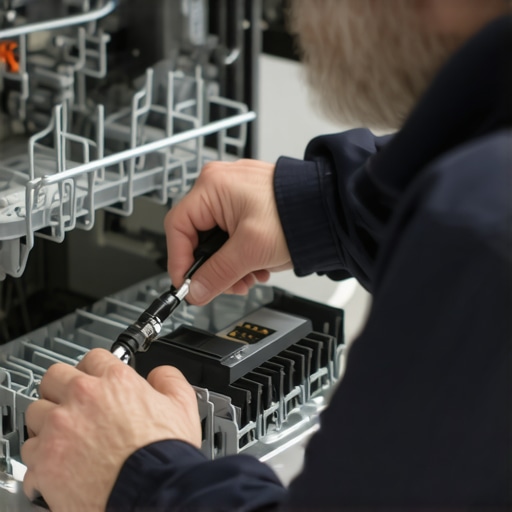How I Discovered the Hidden Troubles of My Dishwasher
It all started on a busy Monday morning when I opened my dishwasher, expecting it to work its usual magic, only to find standing water and a strange smell. Like many homeowners, I felt a mix of frustration and curiosity. Over the years, I’ve learned that dishwasher troubles are quite common, but with a bit of troubleshooting, many issues can be resolved quickly without calling in a repair technician.
Recognizing Common Signs of Dishwasher Problems
One of the first things I noticed was when dishes weren’t coming out clean or the cycle was unusually noisy. Sometimes, the dishwasher would stop mid-cycle or leak water onto the floor. These signs pointed me towards specific problems like clogged filters or faulty door seals. If you’re experiencing similar issues, it might be time for some diagnostic checks. For detailed parts and troubleshooting tips, I often refer to trusted sources like Appliance Bargainz’s Troubleshooting Dishwasher Problems.
My Go-To Tips for Quick Dishwasher Fixes
Over time, I have developed a few go-to tips for diagnosing and fixing common dishwasher issues. For instance, I always start by inspecting the filter and drain hose for blockages. Sometimes, a simple cleaning of these parts can restore proper function. Additionally, checking the door latch and seals helps prevent leaks and ensure the cycle runs smoothly. For more in-depth diagnostics, I recommend exploring guides like Essential Parts Guide for Fast Fixes.
What Makes a Dishwasher Faults Truly Troublesome?
Is It Just a Small Problem or a Sign of Something Bigger?
This question often crosses my mind when troubleshooting. Sometimes, what seems like a minor clog can be a symptom of motor failure or electrical issues. That’s why I always keep an eye on the overall performance and listen for unusual sounds. If you’re unsure, consulting a professional or looking up detailed diagnostics can save you time and prevent further damage.
If you’ve ever faced a stubborn dishwasher issue, I’d love to hear your experience! Feel free to share your tips or ask questions in the comments below. Troubleshooting might seem daunting at first, but with patience and the right knowledge, many fixes are within reach.
Remember, regular maintenance like cleaning filters and inspecting door seals can prevent most problems. For more expert advice, visit authoritative sources such as Consumer Reports.
Uncovering Hidden Dishwasher Issues: What to Look For
When standard troubleshooting doesn’t resolve your dishwasher woes, it’s time to dig deeper. Sometimes, the root of the problem lies beneath the surface—such as wiring issues, electronic control board failures, or subtle leaks that cause long-term damage. Recognizing these less obvious signs can save you from costly repairs down the line. For example, if your dishwasher intermittently stops mid-cycle despite no visible blockages, it might be due to an electrical fault rather than a simple clog. Exploring detailed diagnostics, like those found in Essential Parts Guide for Fast Fixes, can reveal the underlying cause.
How Can Advanced Diagnostics Improve Your Repair Strategy?
Advanced diagnostics involve testing the dishwasher’s electrical components, sensors, and control systems to pinpoint failures. Using multimeters, diagnostic tools, or even manufacturer-specific diagnostic modes can provide insights not apparent through visual inspection alone. For instance, a faulty electronic control board might send incorrect signals, leading to improper filling or drainage. Diagnosing these issues requires a nuanced understanding of appliance electronics, which is why consulting professional resources and repair guides is invaluable. Remember, for complex components like timers and sensors, detailed parts guides—such as Troubleshooting Dishwasher Problems—are essential.

Can Overlooking Minor Symptoms Lead to Major Repairs?
Absolutely. Small, seemingly insignificant signs like a slight increase in cycle duration or a faint burning smell can indicate developing issues that, if left unchecked, may escalate. For example, a persistent leak might initially be a worn door gasket but could eventually cause electrical shorts if water reaches sensitive components. Experts advise addressing minor symptoms promptly, which often involves inspecting and replacing key parts such as door seals, hoses, or filters. Regular maintenance and attentive troubleshooting are your best defenses against costly repairs. For detailed insights on replacing these parts, visit Top Oven Repair Tips.
What Are the Risks of Ignoring Complex Dishwasher Problems?
Ignoring complex issues not only risks further damage but can also compromise safety. Electrical faults, for example, pose shock hazards, and leaks can lead to mold growth or structural damage. Moreover, persistent malfunctions can strain other household appliances, increasing your overall repair costs. Therefore, understanding when to seek professional help is crucial. If troubleshooting steps seem overwhelming or if you’re dealing with electrical components, consulting a qualified technician ensures safety and proper diagnosis. Sharing your experiences or questions about complex dishwasher repairs can help others learn—feel free to comment below or explore more expert advice online. Remember, maintaining good appliance health involves proactive checks and timely repairs, supported by trustworthy sources like Consumer Reports.
Going Beyond the Basics: My Journey into Advanced Dishwasher Diagnostics
Over the years, I’ve realized that dishwasher problems aren’t always straightforward. Sometimes, what appears as a simple clog or leak can be a symptom of more intricate issues lurking beneath the surface. For example, I once faced a dishwasher that stopped mid-cycle without any visible reason. Initially, I checked filters and hoses, but nothing seemed out of place. It was only after diving into the electronic control board diagnostics that I uncovered a failing relay—a component I wouldn’t have suspected without deeper investigation. This experience taught me that understanding electronic diagnostics, such as those discussed in essential repair guides, can be a game-changer in troubleshooting complex issues.
What Are the Subtle Signs That Indicate a Larger Problem?
Sometimes, the signs of trouble are subtle—like a slight delay in cycle times, faint burning smells, or intermittent water drainage. These minor symptoms often precede more serious failures. I remember noticing a faint burning odor during a cycle; it turned out to be a worn-out motor winding that needed replacement before it caused a complete breakdown. It’s a reminder that paying close attention to these nuances can save time and money. Regularly inspecting key parts such as door seals, filters, and electrical connections, as recommended in troubleshooting guides, equips you to catch problems early.
Can Overlooking Minor Symptoms Lead to Costly Repairs?
Absolutely. I’ve learned that neglecting small issues can snowball into major repairs. For instance, ignoring a slow-draining dishwasher might eventually lead to motor failure or electrical shorts. Addressing these minor symptoms promptly—by inspecting and replacing worn parts like door gaskets or hoses—can prevent costly repairs down the line. Moreover, staying proactive with maintenance, such as cleaning filters regularly, keeps the appliance running smoothly and extends its lifespan. Trusted sources like Consumer Reports emphasize the importance of early intervention.
How Do I Approach Diagnosing Electrical and Electronic Failures?
Diagnosing electrical issues requires a mix of patience and technical know-how. I often use multimeters to test wiring continuity and voltage levels. For more advanced diagnostics, some dishwashers have built-in diagnostic modes that reveal error codes, which I’ve found extremely helpful. For example, a dishwasher displaying a specific error code might indicate a faulty sensor or control board—components that are critical yet often overlooked. Exploring detailed parts guides like these repair resources can significantly streamline the troubleshooting process and help you avoid unnecessary replacements.
What Should You Do When Standard Troubleshooting Fails?
If basic checks don’t resolve the issue, it’s time to dig deeper. This might involve testing electronic components or inspecting wiring harnesses for damage. Sometimes, the root cause is a subtle wiring fault or a failing sensor that only becomes apparent through detailed diagnostics. I recommend documenting error codes and symptoms carefully before consulting repair guides or professionals. Remember, safety first—disconnect power before inspecting electrical parts. Sharing your experiences or asking questions in the comments can also be a great way to learn from others’ successes and mistakes.
In my experience, a combination of vigilant observation, regular maintenance, and a willingness to explore beyond surface issues can make all the difference. If you’re interested in mastering advanced troubleshooting, I highly suggest exploring comprehensive guides and staying connected with trusted repair communities. After all, keeping your dishwasher in top shape not only saves money but also ensures that your kitchen runs smoothly, day after day.
Delving into the Complexities of Electronic Control Failures
One of the most perplexing issues I’ve encountered involves electronic control board failures, which can manifest as erratic cycle behavior or complete failure to start. Diagnosing these problems requires a nuanced understanding of appliance electronics, including reading error codes and testing with multimeters. For example, certain dishwasher models display specific error codes that point directly to faulty sensors or control modules, streamlining the troubleshooting process. To deepen this knowledge, I often consult detailed guides like essential repair guides that provide step-by-step diagnostics for complex electronic issues.
How Can I Safely Test and Replace Subtle Electrical Components?
Testing electrical components such as sensors, relays, and wiring harnesses demands both patience and precision. I typically begin by disconnecting power and visually inspecting wiring for damage or corrosion. Using a multimeter, I check for continuity and proper voltage levels, paying close attention to sensor outputs. When replacing parts like sensors or relays, I ensure compatibility by referencing manufacturer part numbers and consulting trusted repair resources. This meticulous approach prevents unnecessary replacements and ensures the longevity of your dishwasher. For comprehensive part identification and detailed troubleshooting tips, I recommend exploring these expert resources.
Can Minor Symptoms Signal Major Future Failures?
Absolutely. Small anomalies, such as slight delays in cycle times or faint electrical burning smells, often precede more severe failures. I recall noticing a faint burning odor during a wash cycle, which prompted me to investigate further. It turned out to be a worn motor winding that could have led to a complete breakdown if left unattended. Addressing these symptoms early—by inspecting and replacing worn parts like door gaskets, filters, or electrical components—can save you significant repair costs down the line. Staying vigilant and proactive is essential for maintaining your appliance’s health. For detailed guidance on component replacements, visit top repair tips.
What Are the Risks of Ignoring Advanced Diagnostic Indicators?
Ignoring subtle warning signs can escalate into costly repairs or safety hazards, especially when electrical faults are involved. For instance, water leaks that seem insignificant might cause electrical shorts or mold growth if ignored. Moreover, persistent issues can strain other household appliances, increasing overall repair expenses. Recognizing these risks underscores the importance of timely diagnostics and professional intervention when needed. Sharing your experiences or seeking advice in repair communities can be invaluable. Remember, regular maintenance and early diagnostics—guided by authoritative sources like Consumer Reports—are your best defenses against major breakdowns.
My Journey into In-Depth Troubleshooting and Its Revelations
Over the years, I’ve learned that many dishwasher problems, initially perceived as minor, can reveal deeper systemic issues. For example, a dishwasher that stalls mid-cycle might seem trivial but could be signaling a failing electronic control board or wiring fault. My most insightful discovery involved a dishwasher that stopped unexpectedly, with error codes pointing to a faulty relay. Further testing uncovered a failing relay on the control board—an issue that required precise diagnostics and part replacement. This experience reinforced my belief that understanding detailed electronic diagnostics, such as those outlined in comprehensive repair guides, can significantly improve troubleshooting outcomes.
What Subtle Signs Might Indicate a Pending Major Breakdown?
Paying close attention to minor symptoms can prevent catastrophic failures. For instance, a slight burning smell or prolonged cycle times can signal motor or control board wear. I once detected a faint burning odor, which led me to replace a worn motor winding before a complete failure occurred. Regular inspection of door seals, filters, and electrical connections—guided by trusted repair advice—can help catch these issues early. This proactive approach ensures your appliance remains reliable and extends its lifespan. For expert part replacement strategies, explore these troubleshooting resources.
How Do You Approach Diagnosing and Replacing Failing Sensors?
Sensor diagnostics involve more than just visual inspection; testing outputs with multimeters and understanding their expected voltage ranges is crucial. When sensors malfunction, they can cause irregular filling, drainage, or cycle errors. I always verify sensor readings against manufacturer specifications before replacing them, ensuring compatibility and proper function. This process minimizes unnecessary replacements and saves money. For detailed sensor testing procedures and replacement tips, I recommend reviewing these advanced diagnostics guides. By mastering sensor diagnostics, you can troubleshoot complex issues more effectively and maintain your dishwasher’s optimal performance.
Things I Wish I Knew Earlier (or You Might Find Surprising)
1. Small Signs Can Signal Major Problems
Early in my troubleshooting journey, I overlooked tiny issues like a faint burning smell or slight cycle delays. Later, I realized these minor symptoms often point to serious underlying faults, such as motor wear or electrical faults, which could lead to costly repairs if ignored.
2. Regular Maintenance Saves Money
Cleaning filters, inspecting door seals, and checking hoses regularly have prevented many issues. It’s like giving your dishwasher a health check-up—simple steps that keep it running smoothly and extend its lifespan.
3. Advanced Diagnostics Are a Game Changer
Using multimeters and reading error codes on modern dishwashers has made complex troubleshooting manageable. I discovered that some problems stem from electronic control board failures, which aren’t visible without proper diagnostics.
4. Sometimes, the Root Cause Is Subtle Wiring or Sensor Failures
Wiring faults or faulty sensors can cause unpredictable behaviors. Carefully testing these components with the right tools and reference guides has helped me resolve issues that seemed impossible at first.
5. Don’t Hesitate to Seek Professional Help When Needed
If diagnostics point to complex electrical or control board issues, I’ve learned that consulting a professional is safest. This not only protects you but also ensures the repair is correctly done the first time.
Resources I’ve Come to Trust Over Time
- Consumer Reports: Their appliance reviews and troubleshooting tips are trustworthy and comprehensive, helping me understand when a repair is truly necessary.
- Appliance Bargainz: Their detailed guides on diagnostics and parts replacement have saved me money and time, especially when dealing with electronic components.
- Manufacturer’s Official Service Manuals: These are invaluable for understanding specific error codes and recommended fixes for my dishwasher model.
Parting Thoughts from My Perspective
Dealing with dishwasher problems has taught me that paying attention to small signs and understanding the basics of diagnostics can prevent bigger headaches down the road. Regular maintenance and being proactive with troubleshooting—especially learning about electronic controls—are key to keeping your appliances in top shape. If this resonated with you, I’d love to hear your own experiences or tips. Share this article with someone who might find it helpful, and don’t hesitate to explore the suggested resources to deepen your understanding of appliance repair. Remember, a little knowledge and patience go a long way in solving household mysteries!

